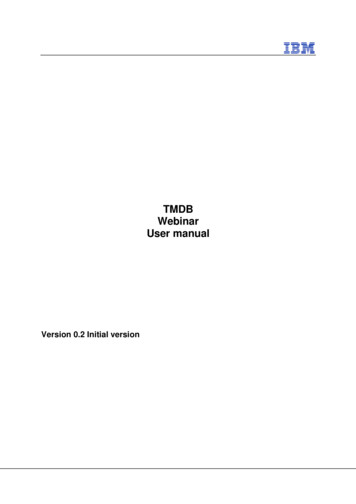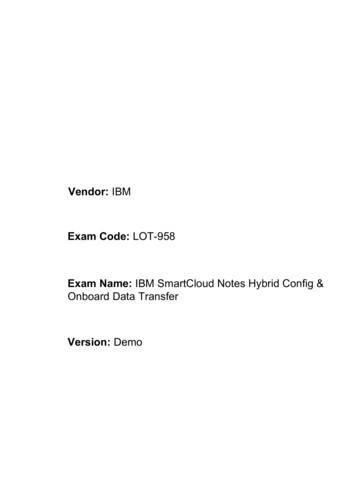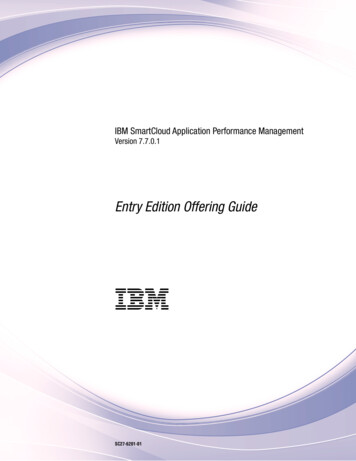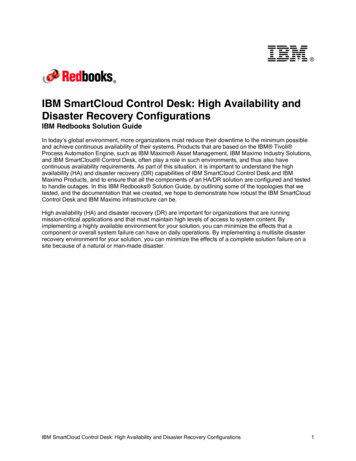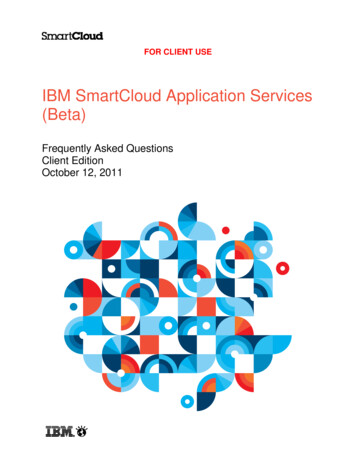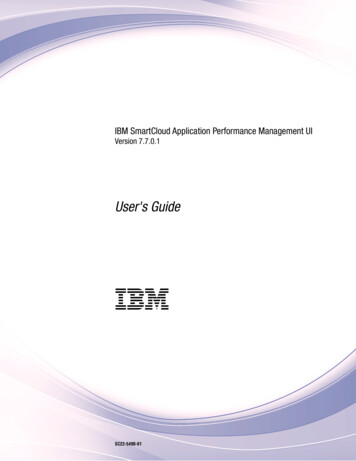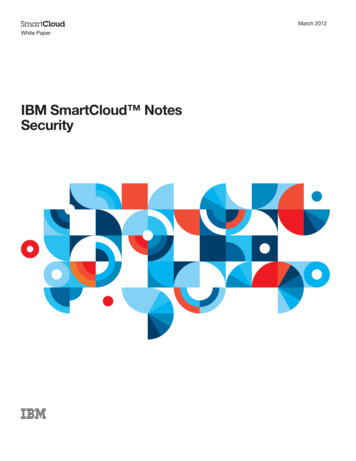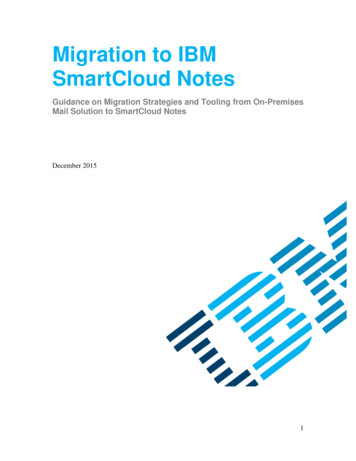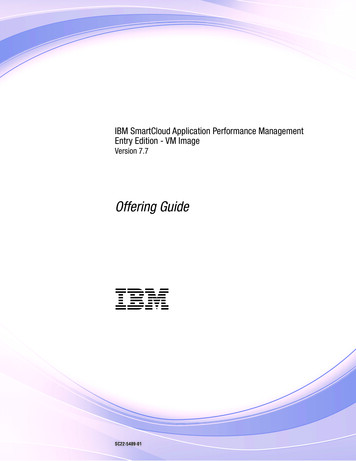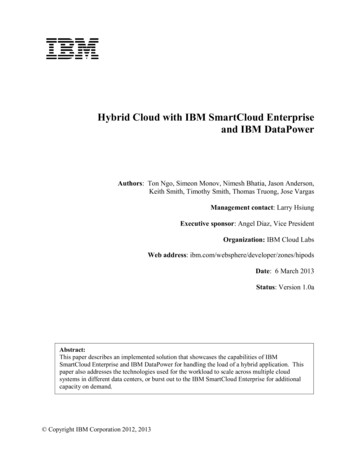
Transcription
Hybrid Cloud with IBM SmartCloud Enterpriseand IBM DataPowerAuthors: Ton Ngo, Simeon Monov, Nimesh Bhatia, Jason Anderson,Keith Smith, Timothy Smith, Thomas Truong, Jose VargasManagement contact: Larry HsiungExecutive sponsor: Angel Diaz, Vice PresidentOrganization: IBM Cloud LabsWeb address: ibm.com/websphere/developer/zones/hipodsDate: 6 March 2013Status: Version 1.0aAbstract:This paper describes an implemented solution that showcases the capabilities of IBMSmartCloud Enterprise and IBM DataPower for handling the load of a hybrid application. Thispaper also addresses the technologies used for the workload to scale across multiple cloudsystems in different data centers, or burst out to the IBM SmartCloud Enterprise for additionalcapacity on demand. Copyright IBM Corporation 2012, 2013
.Note: Before using this information, read the information in “Notices” on page 8ContentsContents.2Introduction.3Business case.3Solution: workload overflow from private to public.4Dashboard and management console.5DataPower application optimization.6Virtual private 7Notices.8 IBM Corporation 2012, 20132Hybrid Cloud with SmartCloud Enterprise and DataPower
IntroductionAs IBM customers map their cloud strategy for the next three to five years, quite often they realize that“one size” does not fit all. The optimal cloud strategy is a judicious combination of hardware, software,pay-as-you-go services, and cloud-delivered business solutions--all complemented with proven expertservices across strategy, migration, integration, management, and delivered by the vendor and anecosystem of partners. Customers need to run certain elements of their business in a private cloud andalso must integrate with elements running on the public cloud. For instance, certain applications wouldrun within the customer corporate firewall (private cloud) while other applications would run on theIBM SmartCloud Enterprise (public cloud), thus optimizing performance, reliability, security, and cost.We call this type of cloud solution a hybrid cloud because it involves both private and public clouds. Weconsider the following scenario where a hybrid cloud solution helps an e-commerce customer meet spikesin business demand by bursting from a private cloud to IBM’s public cloud offering for more capacityduring peak demand, and then pulling back when conditions stabilize.We assume this e-commerce client operates a private cloud environment in their data center. They alsohave an existing account in the IBM SmartCloud Enterprise and the two environments are connected by asecure virtual private network (VPN). The e-commerce application and catalogs are preloaded inSmartCloud Enterprise. Based on prior years' traffic volume for the Mother’s Day sale, the administratorsexpect high demand; and therefore, considering the existing capacity in their private cloud, they definetwo thresholds in the IBM DataPower appliance: lower and upper thresholds for network trafficAs the Web traffic increases on Mother’s Day, the volume exceeds the first threshold, and as a result, thesystem automatically provisions additional resources in SmartCloud Enterprise. As the traffic continues toincrease, crossing the second threshold, the additional resources provisioned in SmartCloud Enterprise arebrought online and DataPower is configured to start routing traffic to the resources in SmartCloudEnterprise. When the Mother’s Day sale is over, the Web traffic returns to the normal volume which isbelow the lower threshold. DataPower then releases the excess resources in SmartCloud Enterprisethrough a deprovisioning task.This paper describes a solution for this hybrid cloud scenario.Business caseCustomers have been refining their cloud strategy to invest in cloud-ready hardware and software. Theyare looking to public cloud offerings for pay-as-you-go services and business solutions. The trade-offtypically expected between the two options is that public cloud cost can be lower in the short termbecause it requires no capital investment, but it can be higher in the long term. Therefore, leveraging bothoptions would yield the best business value. A hybrid cloud solution would enable customers to meetspikes in their application workload by bursting on demand from their data center to the public cloud formore processing capacity without having to invest a large amount in capital expendituresFurthermore, an IBM solution would optimize the performance, reliability, and cost by enabling part of anapplication to run on IBM systems within the corporate firewall while placing other parts in SmartCloudEnterprise. Such an application-aware solution would help to fully automate the ordering, activation, andbalancing of application traffic between the data center and SmartCloud Enterprise, and thus potentiallyallowing the system to dynamically respond to demand fluctuation without intervention by administrators.By leveraging IBM's existing software and systems solutions in data centers (such as DataPower IBM Corporation 2012, 20133Hybrid Cloud with SmartCloud Enterprise and DataPower
appliances and Expert Integrated Systems), and robust public cloud offerings, IBM is uniquely positionedto provide this application-aware hybrid cloud capability.Solution: workload overflow from private to publicWhile e-commerce customers realize that traffic to their Web site can reach high peaks during specialevents such as Mother’s Day, Christmas, or Black Friday, deciding how much capacity to purchase forthese demand spikes is difficult. Investing in too much or too little capacity is not desirable. To betterunderstand the requirements for a solution, we examine the Mother’s Day scenario in more detail. An e-commerce site is hosted on a cluster of IBM WebSphere servers in a private cloudenvironment. The site owner has set up some WebSphere instances on IBM SmartCloud Enterprise to run the ecommerce application, which can be positioned in different geographic locations for optimumperformance. They use a DataPower appliance to monitor incoming throughput to the Web site, and load balanceamong the pool of data center resources. Based on prior year statistics, the e-commerce site administrator sets thresholds in DataPower thatwill trigger the provisioning and deprovisioning of resources. Note that more than one DataPowercan be used in a tier or aggregate topology. When the traffic exceeds the thresholds, DataPower is programmed to request additional resources inSmartCloud Enterprise. (Note: It is possible to use control points to modify behavior, but this is notthe best practice.) When the additional resources become available, DataPower can be set to direct new requests to thenew resources in SmartCloud Enterprise. The resources in SmartCloud Enterprise handle the Web page browsing activities, which is lesscritical. If a customer clicks the “Buy” button, the transaction is routed back to the private cloud to completethe action because the customer profile and payments information are located in the private cloud. If the traffic drops below the threshold, the excess resources in SmartCloud Enterprise aredeprovisioned and the appropriate resource list for DataPower is updated.To implement the solution, IBM Cloud Labs created the following extensions on top of the WebSphereIntelligent Management Pack1 and DataPower Application Optimization (AO) base to:1. Improve the dashboard to monitor cross-cloud workloads.2. Use DataPower AO to monitor the servers in the WebSphere cells to determine the targets for routingWeb traffic.3. Customize the routing algorithm to dynamically assign a weight for each server in the WebSpherecells and determine the percentage of Web traffic to route to each WebSphere application server.4. Set up a VPN to provide connectivity between clouds.The extensions provide the basic functionalities above; however, additional integration is required to implement the extensions as described in this article.Figure 1 shows the high level architecture of the proposed solution. The WebSphere servers are managedby WebSphere Intelligent Management Pack and are provisioned dynamically based on the load.1WebSphere Intelligent Management Pack is packaged with the WebSphere Hypervisor Edition andrequires a separate license. IBM Corporation 2012, 20134Hybrid Cloud with SmartCloud Enterprise and DataPower
Dashboard and management consoleOperating a hybrid environment is complex, therefore we created a dashboard that combines the relevantmonitoring information. Figure 2 shows the main dashboard tracking the activities on both the public andprivate clouds. Figure 3 focuses on the application, showing the Web traffic, the servers available tohandle the requests, and compliance to the service level agreement (SLA). In addition, the dashboard cantrack the resource used on the private cloud, such as central processing unit (CPU), storage, memory,VMs allocated, so that the administrator can receive alerts when demand is about to exceed capacity.Web requestSmart Cloud EnterpriseEhningen, GermanySmart Cloud EnterpriseRaleigh, USAPrivate erWASserverDatabaseVPNFigure 1 - High level architecture of a hybrid cloud IBM Corporation 2012, 20135Hybrid Cloud with SmartCloud Enterprise and DataPower
Figure 2 - Hybrid cloud resource dashboardFigure 3 –Application operation in the hybrid cloudDataPower application optimizationThe DataPower XI50 and XI52 appliances are capable of performing advanced demilitarized zone (DMZ)security operations as well as providing a wide range of enterprise service bus (ESB) capabilities. ESBcapabilities include acting as a reverse proxy where DataPower receives incoming requests and proxiesthem to collections of back-end servers. The application optimization option (AO) is a new DataPowersoftware feature that extends the collection of DMZ and ESB capabilities by providing front side loadbalancing capabilities, and enhancing the back side load balancing capabilities with intelligent load IBM Corporation 2012, 20136Hybrid Cloud with SmartCloud Enterprise and DataPower
distribution (ILD). ILD includes an additional load balancing algorithm (weighted least connections),session affinity, and dynamic configuration. ILD interacts dynamically with a WebSphere cell to routeWeb traffic to the servers in the cell. Together, the new features allow customers to reduce the box countin their DMZ or ESB resulting in a lower total cost of ownership (TCO).Virtual private networkA public cloud and an enterprise data center are normally separated by a firewall. Therefore, for the twoWebSphere cells on the two sides to support an application, connectivity between the members of the twocells is required. The standard practice is to set up a virtual private network (VPN) to allow the membersof the two cells to communicate.ConclusionCloud technology has advanced steadily and several solutions now exist for a Web cluster with elasticscaling. However, these solutions typically operate within a single cloud, limiting the full capability ofthe cloud to meet peak demand. In this paper, we considered using multiple clouds to support elasticscaling, specifically the scenario of an enterprise running an application within its private cloud andoverflowing to a public cloud when the capacity of the private cloud is exceeded. We examined thesupport from existing IBM products and devised a hybrid cloud solution that leverages current supportand minimizes new development effort.AcknowledgementsWe acknowledge the major supporters of this project: Willy Chiu, Larry Hsiung, Nauman Fakhar, Chris Kiernan of the Cloud Labs and HiPODS team Lap Huynh, Ethan Merrill of the IBM Workload Deployer Development Team Neal Alewine, Srinivasan Muralidharan of the IBM DataPower Development Team Andre Manriquez, IBM Client Technical Professional Andrew Grohman, Nicholas Glowacki of the IBM DataPower Technical Sale teamReferences IBM. DataPower Integration Appliance Command Reference. Infocenter. sdatap/4mt/index.jsp?topic tm&resultof %22results%22%20%22result%22.IBM Software. Elastic caching for scalability, dynamic growth and performance. s.l. : IBM, 2011.IBM. DataPower option for Application Optimization. s.l. : IBM, 2011.John Gruber, Brian Tully, Craig Scarborought . Dynamic Provisioning of IBM SmartCloudEnterprise Resource on the F5 BIG-IP. 2010.Alcott, Tom. Can I run a WebSphere Application Server cell over multiple data centers?DeveloperWorks. [Online] 2006.IBM. DataPower XI50 Administrator Guide. s.l. : IBM, 2010. IBM Corporation 2012, 20137Hybrid Cloud with SmartCloud Enterprise and DataPower
NoticesIBM may not offer the products, services, or features discussed in this document in all countries.Consult your local IBM representative for information on the products and services currentlyavailable in your area. Any reference to an IBM product, program, or service is not intended tostate or imply that only that IBM product, program, or service may be used. Any functionallyequivalent product, program, or service that does not infringe any IBM intellectual property rightmay be used instead. However, it is the user's responsibility to evaluate and verify the operationof any non-IBM product, program, or service.IBM may have patents or pending patent applications covering subject matter described in thisdocument. The furnishing of this document does not grant you any license to these patents. Youcan send license inquiries, in writing, to:IBM Director of LicensingIBM CorporationNorth Castle DriveArmonk, NY 10504-1785U.S.A.For license inquiries regarding double-byte character set (DBCS) information, contact the IBMIntellectual Property Department in your country or send inquiries, in writing, to:Intellectual Property LicensingLegal and Intellectual Property LawIBM Japan Ltd.1623-14, Shimotsuruma, Yamato-shiKanagawa 242-8502 JapanThe following paragraph does not apply to the United Kingdom or any other country where suchprovisions are inconsistent with local law: INTERNATIONAL BUSINESS MACHINESCORPORATION PROVIDES THIS PUBLICATION "AS IS" WITHOUT WARRANTY OF ANYKIND, EITHER EXPRESS OR IMPLIED, INCLUDING, BUT NOT LIMITED TO, THE IMPLIEDWARRANTIES OF NON-INFRINGEMENT, MERCHANTABILITY OR FITNESS FOR APARTICULAR PURPOSE. Some states do not allow disclaimer of express or implied warranties incertain transactions, therefore, this statement may not apply to you.This information could include technical inaccuracies or typographical errors. Changes areperiodically made to the information herein; these changes will be incorporated in new editionsof the publication. IBM may make improvements and/or changes in the product(s) and/or theprogram(s) described in this publication at any time without notice.Any references in this information to non-IBM Web sites are provided for convenience only and do not inany manner serve as an endorsement of those Web sites. The materials at those Web sites are not part ofthe materials for this IBM product and use of those Web sites is at your own risk.Any performance data contained herein was determined in a controlled environment. Therefore, the IBM Corporation 2012, 20138Hybrid Cloud with SmartCloud Enterprise and DataPower
results obtained in other operating environments may vary significantly. Some measurements may havebeen made on development-level systems and there is no guarantee that these measurements will be thesame on generally available systems. Furthermore, some measurements may have been estimated throughextrapolation. Actual results may vary. Users of this document should verify the applicable data for theirspecific environment.Information concerning non-IBM products was obtained from the suppliers of those products, theirpublished announcements or other publicly available sources. IBM has not tested those products andcannot confirm the accuracy of performance, compatibility or any other claims related to non-IBMproducts. Questions on the capabilities of non-IBM products should be addressed to the suppliers of thoseproducts.All statements regarding IBM's future direction or intent are subject to change or withdrawal withoutnotice, and represent goals and objectives only.If you are viewing this information softcopy, the photographs and color illustrations may not appear.Special NoticeThe information contained in this document has not been submitted to any formal IBM test and isdistributed AS IS. The use of this information or the implementation of any of these techniques is acustomer responsibility and depends on the customer’s ability to evaluate and integrate them into thecustomer’s operational environment. While IBM may have reviewed each item for accuracy in a specificsituation, there is no guarantee that the same or similar results will be obtained elsewhere. Anyoneattempting to adapt these techniques to their own environments do so at their own risk.While IBM may have reviewed each item for accuracy in a specific situation, IBM offers no guarantee orwarranty to any user that the same or similar results will be obtained elsewhere. Any person attemptingto adapt the techniques contained in this document to their own environment(s) does so at their own risk.Any performance data contained in this document were determined in various controlled laboratoryenvironments and are for reference purposes only. Customers should not adapt these performancenumbers to their own environments as system performance standards. The results that may be obtained inother operating environments may vary significantly. Users of this document should verify the applicabledata for their specific environment.TrademarksIBM, the IBM logo, WebSphere, and DataPower are trademarks of International Business MachinesCorp., registered in many jurisdictions worldwide. Other product and service names might be trademarksof IBM or other companies. A current list of IBM trademarks is available on the Web at "Copyright andtrademark information" at www.ibm.com/legal/copytrade.shtml. IBM Corporation 2012, 20139Hybrid Cloud with SmartCloud Enterprise and DataPower
IBM SmartCloud Enterprise (public cloud), thus optimizing performance, reliability, security, and cost. We call this type of cloud solution a hybrid cloud because it involves both private and public clouds. We consider the following scenario where a hybrid cloud solution helps an e-commerce customer meet spikes

